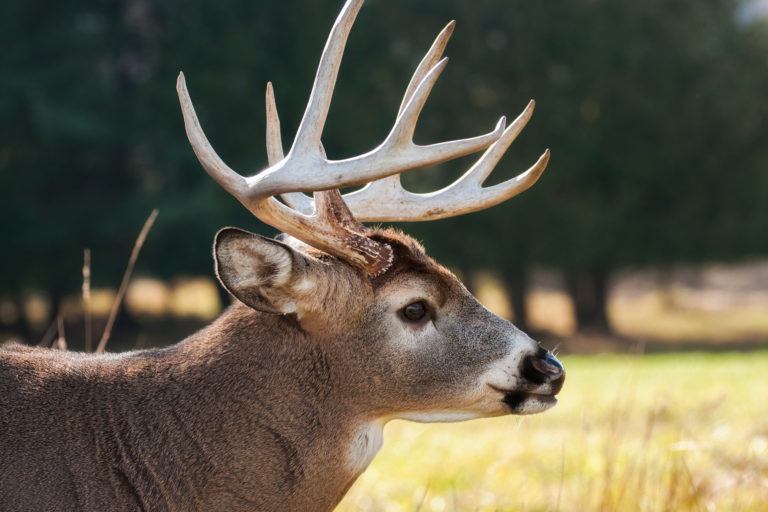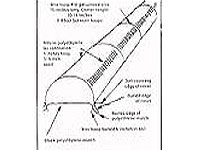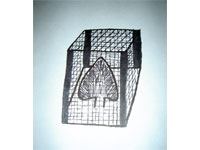
Deer are edge species, meaning they spend much of their time on the perimeter of forests and tree stands. There are two main reasons for this.
First, deer like to eat the young supple shoots and sprouts that are found at these perimeters. In the middle of an old growth forest, there’s just not enough light for saplings and other lush plants to grow. So, when we clear the land where the larger older trees once grew, younger sexier trees are able to grab some light and sprout up. This new growth provides ample nutrition for the darling little deer.
The second reason is safety. When the deer are munchin’ away on baby aspen, balsam or your ornamental plants and shrubs, they can make a quick escape into the dense woods if danger arrives. So you can see why a yard surrounded by trees is a pretty exceptional place to be; there is food within reach and cover nearby from wolves or orange clad hunters or packs of feral dogs. Often when you see a deer eating, they are 10 seconds or less from the heavy cover of a wooded area, swamp, brush, or tall grass.
Damage Prevention
Put up a fence
And not just any fence. Deer are jumping machines. This thing needs to reach the sky. You’ll be looking at 8-10ft high with at least one foot buried underground. I have personally witnessed a white-tailed deer leap over a 7 foot fence, seemingly with ease.
If the idea of the Great Wall of China in your back yard doesn’t appeal to you, you can also try using an electric fence baited with peanut butter. A little zap teaches a quick lesson. Just be careful when using electric fences that dogs, cats, children etc. don’t inadvertently get shocked.
Place tubes around the base of trees
Not only will this protect the little trees from getting munched on, but in the fall, when deer are trying to shed their antlers, they rub them vigorously against the trunks of trees. While this works well for the deer in working those antlers loose, it wreaks havoc on tree bark and can lead to stunted growth or even the death of the tree. Many commercial tree protectors are available, or you can simply make your own by slicing some corrugated drain pipe lengthwise and wrapping it around the tree trunk. If you want to go the commercial route, we suggest the EasyFlex protectors from Dimex, sold at Amazon.

Protect plants with row covers
There are several types of row covers, some are light weight enough to just be draped over your plants while others are designed to be suspended by hoops or stakes. All designs help to keep deer and other pests from devouring your gardens and plants. They have the added benefit of providing some protection against frost (usually just a couple degrees) and retaining a little extra moisture for the plants use.

Erect small cages around vulnerable plants, shrubs and bushes
By using small cages, either homemade with stakes, fencing or chicken wire, or commercially purchased, the deer will never even know what they’re missing. If they’ve already munched your plant a bit and you’re providing protection after the fact, make sure to secure the cage to the ground around the plant with some good long tent stakes Otherwise the deer will just push it over or toss it aside when they come back.
Don’t feed other animals. Deer love a free handout
There is a reason deer hunters sometimes put corn or seed out on the ground (albeit illegal in many states) — it attracts deer like crazy!
They are quite often found grazing seed from underneath birdfeeders. They’ve even been known to grab a birdfeeder with their mouth and tilt it so all that tasty sunflower seed spills to the ground for them to eat. If you have corn out for ducks, turkeys, pheasants, quail or whatever, you will also probably end up with deer.
The good news is that by keeping birdfood and other seeds away from your house, you are also likely to keep mice, rats, and other rodents away. They all love the freebies created by birdfeeder spillage.
Best Deer Repellents
There are three main types of deer repellents: area repellents, contact repellents and electronic repellents. Below you will find several examples of each and a short explanation (as that’s all that’s needed) on how to use each type. I’ve been told over and again that the most important thing to remember when trying to repel deer is to switch things up on a regular basis. Deer have more than a couple brain cells and quickly become used to and undeterred by the same old repellent that doesn’t end up hurting or killing them. Some people switch back and forth with a couple different products every few weeks and other folks use a constant rotation of three or more.
Area Deer Repellents
Area repellents come in liquid, powder or granular form, are applied around problem areas and repel deer with foul odors. A deer’s sense of smell is far more sensitive than a human’s, so something that smells slightly bad to us could smell absolutely putrid to a deer. Examples are Deer Scram, Shake Away, Liquid Fence, Milorganite Fertilizer (though I’ve heard it can’t be sold as an area repellent) and predator urine from coyotes, mountain lions, bobcats etc. In fact, Amazon sells Shake-Off Coyote/Fox granules.
Contact Deer Repellents
Contact repellents are generally liquid, applied by spraying directly onto the plants and taste and smell terrible to deer. Examples are Deer Away, Scoot Deer, Miller’s Hot Sauce, Deer Off, Hinder and predator urine.
Just be sure to get something you can live with, too. If you are applying this stuff near your patio or deck, you might be as repulsed by the scent as the deer are!
Electronic Deer Repellents
Electronic repellents are attached to an object such as a stake or tree in the problem areas and generally work by irritating, scaring or startling the deer. YardGard Electronic Deer Repeller and DeerGard Silent Deer Repeller both emit sonic and ultrasonic sound, are motion activated or can be set to run continuously. Deer Chaser is a motion sensitive device that uses a very bright LED light and an FM radio to scare deer away.
Such devices may (but we can’t prove it) also keep raccoons away and deter mice, a nice extra benefit.
Natural Deer Control
Egg spray
Using egg spray is a old-timer’s way of keeping deer away from their gardens and flowerbeds.
Make a spray of 20% whole egg and 80% water. Before mixing in the egg remove the chalaza (the white membrane around the yolk) to avoid clogging the sprayer. Reapply every thirty days or after a rain. Deer associate the smell of rot and decay with the presence of predators.
Release the hounds!
Got a pooch? Put it outside. Deer and dogs don’t mix. Make sure to keep the dog on a chain or lead though. You don’t want Fido chasing the deer into the woods and getting lost. The chain also keeps the dog from getting too close to the deer and getting kicked.
The same goes for cattle. While not as many of us have cows as we did 50 years ago, if you are fortunate enough to have cattle or horses on your land, put them in the area where you want to keep the deer away from. They don’t mix at all and you won’t see a deer for days.
Pigs?
Yup, pigs. It’s been suggested that fencing a few porkers around the garden will keep deer out. That might be easier said than done if you live in the big city, but if you are in a rural area, perhaps you have a farmer neighbor who could use another pasture for his or her pigs.
Hang mesh bags filled with deterrents
Use human hair, feather meal, blood meal, or tankage (residue from tanks where animal carcasses have been steamed and the fat rendered). Deer associate the smell of rot and decay with predators. Hang the bags around trouble spots. Soap, mothballs and creosote are said to work too. Replace bags monthly and remember these methods are all hearsay and may not be a perfect solution.
Scare devices
The Scare Crow is a motion sensing sprinkler and is a great method for getting rid of deer. The deer can’t possibly get hurt, surrounding plants and grasses get some extra water, and other critters such as squirrels, raccoons, dogs and cats are also repelled. It could also be fun to try fireworks, strobe lights, sirens, horns, music or right wing talk radio.
The thing that will really scare a deer is motion. Something that physically moves — like the Scare Crow Sprinkler — is really effective in this regard. If the deer senses that there is a moving object around it, it will get very spooked and have the instinct to run away, fast. Find it here on Amazon.
Deer Control via Landscaping
Plant things deer don’t particularly like
There’s plenty of attractive flora that deer tend to leave alone. Here are just a few: Allegheny spurge, ferns, wormwood, lamb’s ears, forget-me-nots, carnations, alyssum, foxgloves, poppies, lily-of-the-valley, daffodils, lavender and black eyed susans.
The more open or exposed a deer feels, the less likely it will be to enjoy your property, so consider cutting those buckthorn, getting rid of brush, and opening things up a bit.
Create a diversion
Pick some plants that are favorites of deer and plant them away from the plants you don’t want them to eat. The idea is that the deer will just stay where the more delectable plants are. Try using dogwood, crabapple, viburnum, pyracanthus, burning bush, burberry or white cedar.
Don’t over fertilize
If the deer are eating your grass and not your shrubs, you’re probably over fertilizing. Over fertilized grass is big, plump and juicy and makes the deer want to come back for seconds.
To hunt? Or Not?
We will not spend a lot of time on the hunting option, for two reasons: It is not a viable option for the vast majority of homeowners who live in or near a city or town; and you can only hunt in very small fractions of the year, so most of the time, it is not a real possibility.
But, if you are one of the lucky few who owns acreage way out in the country, and it would be safe to hunt in the area, you may want to find a hunter (or you can do it yourself) to thin the herd. Just know that come spring, there will be new deer around, and a good chance the problem will return without the proper deterrents.